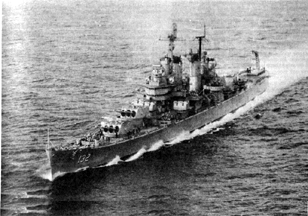
|
|
|||||||||
|
|
|||||||||
|
|
|||||||||
 |
|||||||||
 |
|||||||||
 |
|||||||||
| Macon (CA-132: dp. 13,800; 1. 874'11"; b. 70'10"; dr. 20'e"; s. 33 k.; cpl. 1,142; a. 9 8", 12 5", 46 40mm., 28 20mm.;cl. Baltimore ) Macon (CA-132) was laid down 14 June 1943 by the New York Shipbuilding Corp., Camden, N.J.; launched 15 October 1944; sponsored by Mrs. Charles F. Bowden wife of the mayor of Macon, Gal, and commissioned 26 August 1945 at Philadelphia, Capt. Edward E. Pare in command. Macon's first fleet assignment was with the 8th Fleet which she Joined soon after her shakedown cruise. Sailing with the fleet for maneuvers in the Caribbean, she departed Norfolk on 19 April 1946, returning to New York 7 May. On 4 June Macon arrived at Norfolk for duty as a test ship for the operational development force. Over the nexst 4 years the cruiser periodically received esperimental equipment in the Philadelphia Naval Shipyard, conducted tests of the new equipment while she served as an antiaircraft gunnery schoolship, and training naval reservists off the Atlantic and gulf coasts of the United States. She also participated in a midshipmen summer cruise to Europe in 1948. Her experimental duties continued until 12 April 1950 when she decommissioned and went into reserve at Philadelphia. With the outbreak of the Korean conflict, June 1950 Macon was ordered reactivated. She recommissioned at Philadelphia 16 October 1950 and, upon completion of refresher training, became the flagship of Cruiser Division 6 in the Atlantic. By the end of 1959 Macon had conducted six midshipmen summer cruises and had spent the fall and winter season of almost every year as a guardian of freedom and liberty with the mighty 6th Fleet. She patrolled in the eastern Mediterranean during the Suez crisis of 1956; took part in the International Naval Review celebrating the 350th Anniversary of the foundation of Jamestown, 12 June 1957; and participated in the NATO exercise operation "Strikeback", conducted in the North Sea and Arctic Ocean in September 1957. Besides these duties, Maeon continued to receive experimental equipment for testing throughout the period. Having also received missile equipment during January March 1956, she launched the first Regulus Missile from an Atlantic Fleet cruiser on 8 May while anchored off the North Carolina coast, and then continued tests of the missile as she completed her cycle of Atlantic Fleet operations. On the night of 19 to 20 January 1959, Macon, steaming from Cartagena to Marseilles, diverted from her course and sped to the aid of burning Italian merchant ship Maria Amata. Macon's crew fought the flames, but the ship was soon beyond salvage. Macon then carried the merchantman's crew to Valencia, Spain. The following January, Macon, carrying the U.S. Navy Band, departed Norfolk for a good will cruise to South American ports. While on this tour, six members of the band perished in a plane crash en route to perform at a state dinner for Brazilian President J. Kubitseek. With Argentine Naval personnel participating, Macon’s crew held memorial services in Buenos Aires Harbor on 28 February. Completing this cruise at Rio de Janeiro on 10 March, Macon returned to Boston to resume her cycle of operations with the Atlantic Fleet. She was placed out of commission in reserve at Philadelphia on 10 March 1961 and remains there into 1969. |
|||||||||